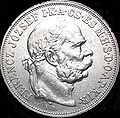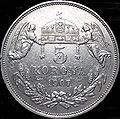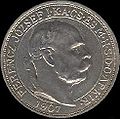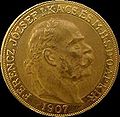This section needs additional citations for verification .(October 2015) |
The coins of the Austro-Hungarian krone were minted with a different design (but the same technical parameters) in Austria and Hungary.
This section needs additional citations for verification .(October 2015) |
The coins of the Austro-Hungarian krone were minted with a different design (but the same technical parameters) in Austria and Hungary.
The Austrian coins were minted in Vienna, and came in face values of 1, 2, 10, and 20 heller; and 1, 2, 5, 10, 20, and 100 kronen. The Austrian 100-krone coin is still being minted, with a 1915 mint mark to enable Austrians to take advantage of a grandfather clause in the law regarding private ownership of gold bullion.[ citation needed ]
The Hungarian coins were minted in the famous mint of Körmöcbánya (now Kremnica, Slovakia). Hungarian coins were minted with face values of 1, 2, 10 and 20 fillér; and 1, 2, 5, 10, 20 and 100 korona.
| Korona-fillér coins – Regular issues | ||||||||||
|---|---|---|---|---|---|---|---|---|---|---|
| Image | Value | Technical parameters | Description | Date of first minting | ||||||
| Obverse | Reverse | Diameter | Thickness | Mass | Composition | Edge | Obverse | Reverse | ||
| | | 1 f | 17 mm | 1.1 mm | 1.67 g | Bronze 95% copper 4% tin 1% zinc | Smooth | "MAGYAR KIRÁLYI VÁLTÓPÉNZ" 1 , Holy Crown of Hungary, year of minting | Value, mintmark | 1892 |
| | | 2 f | 19 mm | 1.5 mm | 3.33 g | |||||
| | | 2 f | 17.3 mm | 1.7 mm | 2.78 g | Iron | Smooth | "MAGYAR KIRÁLYI VÁLTÓPÉNZ", Holy Crown of Hungary, year of mining | Value, mintmark | 1916 |
| | | 10 f | 19.0 mm | 1.4 mm | 3.0 g | Nickel | Serrated | 1892 | ||
| | Alpacca 50% copper 40% zinc 10% nickel | 1914 | ||||||||
| 1.5 mm | Iron | 1916 (1915) | ||||||||
 |  | 20 f | 21.0 mm | 1.6 mm | 4.0 g | Nickel | 1892 | |||
 |  | 1.5 mm | 3.33 g | Iron | Smooth | 1916 | ||||
 |  | 1 K | 23.0 mm | 5.0 g | 835‰ silver | "BIZALMAM AZ ŐSI ERÉNYBEN" 2 , ornament | "FERENCZ JÓZSEF I.K.A.CS. ÉS M.H.S.D.O.AP.KIR." 3 , I. Ferenc József, mintmark | Holy Crown of Hungary, value | 1892 | |
 |  | "FERENCZ JÓZSEF I.K.A.CS. ÉS M.H.S.D.O.AP.KIR.", I. Ferenc József (older), mintmark | 1912 | |||||||
 |  | 2 K | 27.0 mm | 2.0 mm | 10.0 g | "FERENCZ JÓZSEF I.K.A.CS. ÉS M.H.S.D.O.AP.KIR.", I. Ferenc József, mintmark | ||||
 |  | 5 K | 36.0 mm | 2.6 mm | 24.0 g | 900‰ silver | 1900 | |||
| | | 10 K | 19.0 mm | 0.9 mm | 3.39 g | 900‰ gold | ornament | "FERENCZ JÓZSEF I.K.A.CS. ÉS M.H.S.D.O.AP.KIR.", standing I. Ferenc József | Middle Coat of Arms with angels, value, mintmark | 1892 |
 |  | 20 K | 21.0 mm | 1.4 mm | 6.78 g | "BIZALMAM AZ ŐSI ERÉNYBEN", ornament | ||||
 |  | 20 K | Middle Coat of Arms (including Bosnia) with angels, value, mintmark | 1914 | ||||||
 |  | 20 K | "HARCBAN ÉS BÉKÉBEN A NEMZETTEL A HAZÁÉRT" 4 | "KÁROLY I.K.A.CS. ÉS M.H.SZ.D.O.AP.KIR." 5 , standing IV. Károly | 1918 | |||||
 |  | 100 K | 37.0 mm | 2.0 mm | 33.9 g | "BIZALMAM AZ ŐSI ERÉNYBEN", ornament | "FERENCZ JÓZSEF I.K.A.CS. ÉS M.H.S.D.O.AP.KIR.", standing I. Ferenc József | Middle Coat of Arms with angels, value, mintmark | 1907 | |
| Korona coins – Commemorative issues | ||||||||||
 |  | 1 K | 23.0 mm | 1.5 mm | 5.0 g | 835‰ silver | "BIZALMAM AZ ŐSI ERÉNYBEN", ornament | "AZ EZERÉVES MAGYARORSZÁG EMLÉKÉRE" 6 , I. Ferenc József, mintmark, value | Árpád | 1896 |
 |  | 5 K | 36.0 mm | 2.6 mm | 24.0 g | 900‰ silver | "FERENCZ JÓZSEF I.K.A.CS. ÉS M.H.S.D.O.AP.KIR.", I. Ferenc József | "MEGKORONÁZTATÁSÁNAK NEGYVENEDIK ÉVFORDULÓJÁRA 1867-1907" 7 , coronation scene, value, mintmark | 1907 [1] | |
 |  | 100 K | 37.0 mm | 2.0 mm | 33.9 g | 900‰ gold | "BIZALMAM AZ ŐSI ERÉNYBEN", ornament | "FERENCZ JÓZSEF I.K.A.CS. ÉS M.H.S.D.O.AP.KIR.", I. Ferenc József | "MEGKORONÁZTATÁSÁNAK NEGYVENEDIK ÉVFORDULÓJÁRA 1867-1907", coronation scene, value, mintmark | 1907 |
| These images are to scale at 2.5 pixels per millimeter, a standard for world coins. For table standards, see the coin specification table. | ||||||||||